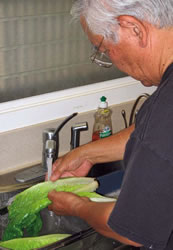Tips To Avoid Food Contamination

|
We dietitians like to say that there’s no such thing as “bad foods” because all foods can fit into a healthful diet. The exceptions are foods that have been contaminated in some way that leads to a food-borne illness when consumed. This is bad, bad food.
Food-borne illnesses are diseases that are passed to humans by food. The process begins with the ingestion of contaminated food or beverage. There are many different types of contaminants (microorganism, chemical or physical contaminants) which result in a variety of symptoms that show up once consumed.
Common symptoms are gastrointestinal tract disturbances such as nausea, abdominal cramps, vomiting and diarrhea. Headaches and fever may also occur. Symptoms typically subside in a matter of a few days without medical treatment. These occurrences may seem like an acute event (you eat something bad, get sick and feel better shortly after). However, food-borne illnesses can develop into secondary long-term illnesses that show up later as a chronic disease.
For example, it may affect the joints, kidneys, nervous system or heart. The U.S. Food and Drug Administration estimates that 2 to 3 percent of the 76 million cases of food-borne illnesses every year develop into secondary long-term illnesses. Now that’s a good reason to pay attention to the safety of your food!
Here are a few tips: Personal hygiene: Hand-washing is the most important aspect of personal hygiene in terms of keeping food safe. Wash hands for at least 20 seconds by scrubbing fingers, hands and arms with hot water and soap, and drying off with either a single use paper towel or clean towel. While cooking or handling food, make sure to wash your hands often (i.e. after touching your hair or body, sneezing, or handling anything other than food). Removing jewelry is also a good idea as it can harbor bacteria or physically contaminate your food.
Avoid cross contamination:
The reason we cook food, other than for eating preference, is to kill microorganisms. Raw meat, poultry and seafood are potentially hazardous foods that should be cleaned or prepared in separate areas from produce, ready-to-eat or already cooked foods. Separate utensils and containers should also be used (i.e. the plate used to marinate raw chicken should not be reused for serving cooked chicken). Be sure to also wash/sanitize hands and work surfaces after preparing raw foods.
Temperature awareness: Food-borne microorganisms grow rapidly between the temperature range of 40°F and 140°F (a.k.a.
the temperature danger zone). Foods are likely to pass within this danger zone when they are thawed, cooked, cooled or reheated. Therefore, minimizing time of food exposure to the temperature danger zone, reduces microorganism growth. By simply controlling this single factor through proper food handling, the chance of food related illness is greatly reduced.
Thawing frozen foods: Thaw frozen foods in the refrigerator or by using the microwave defrost cycle. Never thaw foods out of the refrigerator at room temperature. It’s guaranteed to pass through the temperature danger zone and remain there for too long of a period before completely defrosting. Can you say microorganism city?
Cooking food to proper temperatures: Cooking meat, poultry and eggs thoroughly is a good way to ensure you are killing bacteria sufficiently. Use a thermometer to measure the internal temperature of foods.
Poultry: 165°F Ground meats: 160°F Beef, veal and lamb: 145°F Fish: 145°F Clams, oysters and mussels until shells open; shrimp, lobster and crab until meat is pearly and opaque
Reheating all foods: 165°F Serving/holding foods at proper temperatures: When serving or holding food (for example, at a buffet table or at a picnic) a simple rule is to keep cold foods cold (under 40°F) and hot foods hot (over 140°F). Use coolers, ice/ice packs to keep items cold and hot plates or warmers to keep items hot. Use a thermometer to verify food temperatures. If this is not possible, don’t leave food out at room temperature for more than two hours and no more than one hour if it’s hotter than 90°F outside.
Leftovers: Refrigerate any leftover food as soon as possible. Keep refrigerated leftovers for a maximum of four days. If you have any doubt about whether a food is OK to eat, just throw it out! Reheat all leftovers to an internal temperature of 165°F before consuming.
Purchasing food from safe sources: With recent news of multiple food contamination and product recalls of manufactured items or ingredients sourced from China, India, Mexico and the U.S., consider questioning what, where and who is the source of your food purchase. Since ingredient suppliers, food manufacturers and retailers are being more scrupulous about these details, we (the end consumer) need to be vigilant, too! Our vigilance combined with safe food-handling practices will allow us to enjoy safe and illness free eats.
Mia Inoshita is a dietitian for Meadow Gold Dairies Hawaii. .(JavaScript must be enabled to view this email address)
E-mail this story | Print this page | Comments (0) | Archive | RSS Comments (0) |
Most Recent Comment(s):





 Del.icio.us
Del.icio.us







